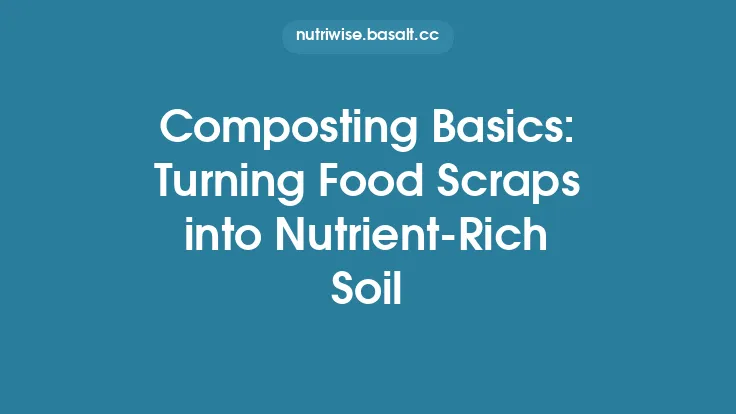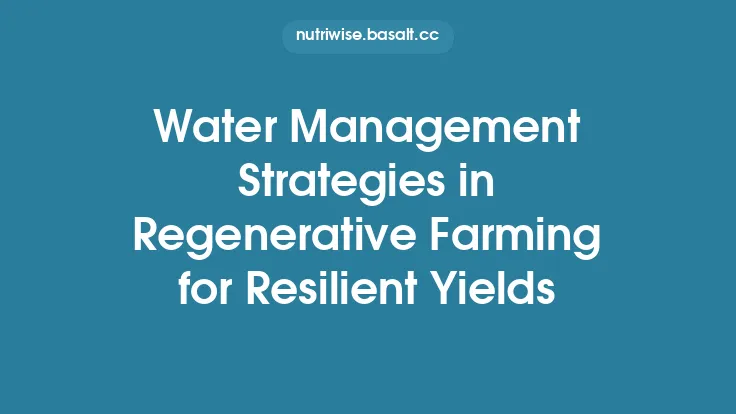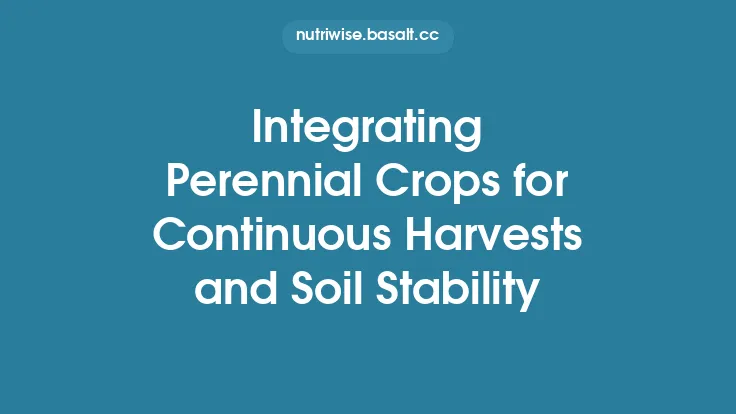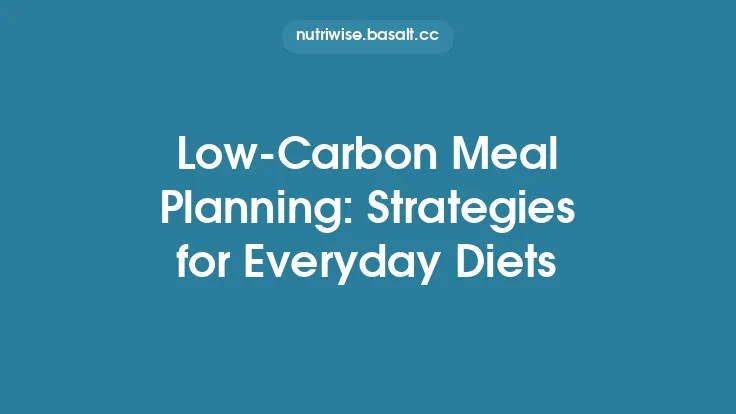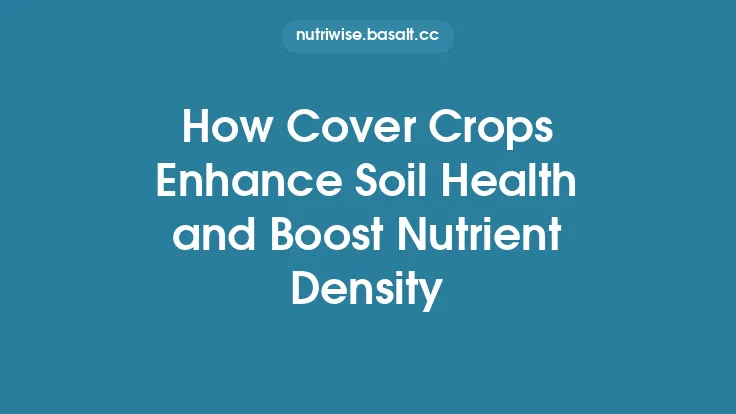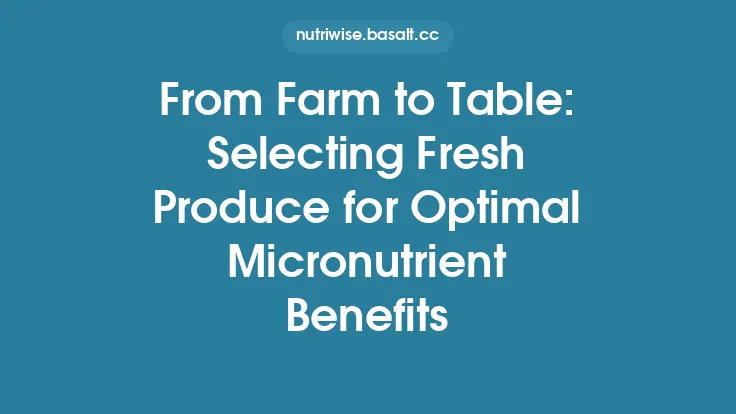Compost integration is one of the most tangible ways regenerative agriculture turns what would be waste into a living, nutrient‑rich medium that fuels healthy crops and resilient ecosystems. By harnessing the natural processes of decomposition, farmers can close nutrient loops, reduce reliance on synthetic inputs, and build soil that supports higher yields and better plant health over the long term. This article walks through the science, practical design, and management strategies needed to make compost a cornerstone of a regenerative farm, while staying focused on evergreen principles that remain relevant regardless of climate, scale, or market trends.
Why Compost Matters in Regenerative Agriculture
Compost is more than a simple fertilizer; it is a complex, biologically active amendment that improves soil structure, water‑holding capacity, and biological diversity. In regenerative systems, the goal is to enhance the soil’s ability to self‑regulate, capture carbon, and supply plants with a balanced suite of macro‑ and micronutrients. Compost contributes to each of these objectives by:
- Increasing organic matter – Boosts aggregate stability, reduces erosion, and creates pore space for roots and soil fauna.
- Supplying a slow‑release nutrient pool – Unlike soluble synthetic fertilizers, nutrients in compost are mineralized gradually, matching plant uptake and minimizing leaching.
- Stimulating microbial activity – Provides food and habitat for bacteria, fungi, actinomycetes, and protozoa that drive nutrient cycling and disease suppression.
- Enhancing cation exchange capacity (CEC) – Higher CEC improves the soil’s ability to retain essential nutrients such as potassium, calcium, and magnesium.
These benefits align directly with the regenerative principle of “building soil health to support plant health,” making compost a foundational practice for any farmer seeking to move away from external inputs.
The Science of Composting: Microbial Processes and Nutrient Transformation
Compost formation is a succession of microbial communities that break down organic matter through enzymatic reactions. Understanding this succession helps farmers manage the process for optimal quality.
| Phase | Dominant Microbes | Temperature Range | Primary Activity |
|---|---|---|---|
| Mesophilic | Bacteria (e.g., *Pseudomonas, Bacillus*) | 20‑40 °C (68‑104 °F) | Rapid breakdown of soluble sugars and proteins |
| Thermophilic | Thermophilic bacteria (*Thermus, Bacillus spp.) and fungi (Aspergillus, Penicillium*) | 45‑70 °C (113‑158 °F) | Degradation of cellulose, hemicellulose, and lignin; pathogen kill‑off |
| Cooling/Secondary | Actinomycetes, mesophilic fungi, protozoa | 30‑45 °C (86‑113 °F) | Further decomposition of resistant compounds; humus formation |
| Maturation | Soil microbes, mycorrhizal fungi | <30 °C (86 °F) | Stabilization of organic matter into humus; nutrient mineralization |
Key biochemical transformations include:
- Carbon mineralization – Microbes respire carbon as CO₂, reducing the C‑to‑N ratio and concentrating nutrients.
- Nitrogen mineralization (ammonification) – Organic nitrogen is converted to ammonium (NH₄⁺), later nitrified to nitrate (NO₃⁻) by nitrifying bacteria.
- Phosphorus solubilization – Certain fungi and bacteria release organic acids that liberate phosphorus bound in organic compounds.
- Micronutrient chelation – Humic substances bind trace elements (Fe, Mn, Zn, Cu), making them more plant‑available.
A well‑managed compost will progress through these phases, reaching a stable, humus‑rich end product with a C:N ratio typically between 10:1 and 20:1, pH near neutral, and a diverse microbial community.
Types of Organic Waste Suitable for Composting
Regenerative farms generate a variety of organic residues that can be diverted into compost. Selecting the right mix influences the speed of decomposition, nutrient balance, and final product quality.
| Waste Stream | Typical C:N Ratio | Nutrient Highlights | Considerations |
|---|---|---|---|
| Crop residues (stalks, leaves, husks) | 30‑80:1 | High carbon, moderate potassium | May require nitrogen amendment to avoid nitrogen immobilization |
| Animal manures (cattle, poultry, swine) | 10‑25:1 | Rich in nitrogen, phosphorus, calcium | Must be aged to reduce pathogen risk; high moisture content |
| Food processing by‑products (fruit pulp, vegetable trimmings) | 15‑30:1 | Balanced macro‑nutrients, high micronutrients | Often high moisture; may need bulking agents |
| Green waste (grass clippings, garden trimmings) | 15‑25:1 | Good nitrogen source, rapid decomposition | Can mat if not turned; avoid herbicide‑treated material |
| Paper and cardboard (non‑coated) | 150‑200:1 | Very high carbon, low nutrients | Useful as bulking agent; must be shredded for better aeration |
| Wood chips and sawdust | 200‑500:1 | Very high carbon, structural bulk | Require substantial nitrogen addition; slow to decompose |
A balanced feedstock mix typically targets an initial C:N ratio of 25‑30:1. Adjustments are made by adding high‑nitrogen materials (e.g., manures, green waste) or high‑carbon bulking agents (e.g., straw, wood chips) to achieve the target.
Designing an Effective Compost System for Farm Scale
While small backyard bins are common, regenerative farms often need larger, more controllable systems. The design should address aeration, moisture control, temperature monitoring, and ease of turning.
- Choice of Structure
- Windrow piles – Long, narrow rows (1‑2 m high, 2‑3 m wide) that can be mechanically turned with a front‑end loader or specialized turner. Ideal for high‑volume operations.
- In‑vessel reactors – Enclosed containers (e.g., concrete or steel bins) that allow precise control of temperature, moisture, and aeration. Useful where space is limited or odor control is required.
- Static aerated piles – Use perforated pipes or forced‑air systems to supply oxygen without turning. Suitable for low‑labor contexts but may require more monitoring.
- Aeration and Turning
- Aim for an oxygen concentration of >5 % in the pile.
- Turn the pile every 5‑7 days during the thermophilic phase to redistribute heat and oxygen, then less frequently (every 2‑3 weeks) during the cooling phase.
- Moisture Management
- Target moisture content of 50‑60 % (by weight).
- Use a simple squeeze test: a handful of material should feel like a wrung‑out sponge—no free water, but it should clump when squeezed.
- Temperature Monitoring
- Insert a compost thermometer at the core of the pile.
- Maintain ≥55 °C (131 °F) for at least three consecutive days to ensure pathogen kill‑off and weed seed destruction.
- Leachate Control
- Install a collection tray or impermeable base beneath windrows to capture runoff.
- Leachate can be recirculated into the pile (after testing for pH and contaminants) or applied as a liquid amendment to fields, provided it meets local regulations.
- Curing Phase
- After the active composting phase, allow the material to cure for 4‑8 weeks.
- During curing, the pile should be kept moist and turned minimally, allowing humus formation and stabilization.
Integrating Compost into Crop Production
Once the compost reaches maturity, it can be incorporated into the cropping system through several pathways, each with specific timing and application considerations.
1. Pre‑Plant Incorporation
- Method: Spread compost at a rate of 10‑30 t ha⁻¹ (depending on soil test results) and incorporate to a depth of 10‑15 cm using a disc or chisel plow.
- Timing: Apply 2‑4 weeks before planting to allow mineralization of nutrients and stabilization of soil structure.
2. Side‑Dressing
- Method: Apply compost in bands or rows alongside growing crops (e.g., corn, soybeans) at 2‑5 t ha⁻¹ during early vegetative stages.
- Benefit: Provides a localized nutrient source that can be accessed by root systems as they expand.
3. Top‑Dressing
- Method: Broadcast a thin layer (0.5‑1 cm) of compost over the soil surface during the growing season, especially for high‑value horticultural crops.
- Consideration: Avoid excessive surface mulch that could impede emergence; combine with light irrigation to integrate the material.
4. Seedbed Amendment
- Method: Mix compost directly into the seedbed at 5‑10 t ha⁻¹ to improve germination conditions for small‑seeded crops (e.g., lettuce, radish).
- Result: Enhanced seed‑to‑seedling transition due to improved moisture retention and nutrient availability.
5. Cover Crop Integration (Note: Not a focus on cover‑crop benefits)
- While cover crops are a separate regenerative practice, compost can be applied to the standing cover crop to enrich the subsequent cash crop’s soil. This step is optional and should be aligned with overall farm planning.
Timing and Application Rates for Different Crops
| Crop Type | Recommended Compost Rate (t ha⁻¹) | Optimal Application Window |
|---|---|---|
| Cereal grains (wheat, barley, oats) | 15‑25 | Pre‑plant, 3‑4 weeks before sowing |
| Root vegetables (carrots, potatoes, beets) | 20‑30 | Pre‑plant, 2‑3 weeks before planting; side‑dress mid‑season if needed |
| Legumes (beans, peas) | 10‑20 | Pre‑plant; nitrogen fixation reduces need for high N inputs |
| Fruit trees (orchards) | 30‑40 (annual) | Early spring before bud break; incorporate into the top 20 cm of soil |
| High‑value horticulture (tomatoes, peppers, cucumbers) | 5‑15 (top‑dress) | At transplant, then again at fruit set |
| Pasture grasses | 10‑20 (broadcast) | Early spring or after grazing rest period |
Soil testing before and after compost application is essential to fine‑tune rates, especially for phosphorus and potassium, which can accumulate over time.
Monitoring Soil Health Post‑Application
Effective compost integration is a feedback loop. Regular monitoring ensures that the amendment is delivering the intended benefits and helps avoid over‑application.
- Soil Organic Matter (SOM) – Measure using loss‑on‑ignition or dry combustion. Aim for a 0.5‑1 % annual increase in SOM on mineral soils.
- Bulk Density – Lower bulk density indicates improved structure; target values <1.3 g cm⁻³ for tilled soils.
- Microbial Biomass Carbon (MBC) – Use fumigation‑extraction; a 20‑30 % rise after compost addition signals a thriving microbial community.
- Nutrient Availability – Conduct quarterly soil tests for nitrate, ammonium, phosphorus (Olsen P), and potassium. Adjust future compost rates based on trends.
- Water Infiltration Rate – Perform double‑ring infiltrometer tests; a 10‑20 % increase post‑compost suggests better porosity.
Documenting these metrics over multiple seasons provides a data‑driven basis for refining compost strategies and demonstrating regenerative outcomes to stakeholders.
Challenges and Solutions in Compost Integration
| Challenge | Underlying Cause | Practical Solution |
|---|---|---|
| Nitrogen Immobilization | High‑carbon feedstocks (e.g., straw) tie up nitrogen during decomposition. | Pre‑mix nitrogen‑rich materials (manure, green waste) to achieve target C:N; consider a short “pre‑compost” phase before field application. |
| Pathogen Survival | Inadequate thermophilic phase or low pile temperature. | Ensure pile reaches ≥55 °C for ≥3 days; use temperature probes and turn more frequently if needed. |
| Weed Seed Viability | Insufficient heat or short thermophilic duration. | Extend the high‑temperature phase; add a brief “heat‑kill” step by covering the pile with a tarp to retain heat. |
| Odor Issues | Excess moisture or anaerobic pockets. | Maintain moisture at 50‑60 %; turn regularly to introduce oxygen; add bulking agents to improve aeration. |
| Heavy Metal Accumulation | Use of contaminated feedstocks (e.g., industrial waste). | Source feedstocks from verified, clean origins; test compost for heavy metals before field use. |
| Logistical Constraints | Large volumes require equipment and labor. | Invest in mechanized turners or in‑vessel systems; schedule compost production during off‑season periods to balance labor. |
Proactive management of these issues ensures that compost remains a reliable, low‑risk component of a regenerative farm’s nutrient strategy.
Economic and Environmental Benefits
Economic Returns
- Reduced Input Costs – Substituting synthetic N‑P‑K fertilizers with on‑farm compost can cut fertilizer expenses by 30‑50 % for many crops.
- Yield Stability – Improved soil water retention and nutrient cycling lead to more consistent yields, especially under variable weather.
- Revenue from Waste Streams – Selling or exchanging compostable waste (e.g., food‑processing residues) creates an additional income stream or reduces disposal fees.
Environmental Gains
- Greenhouse Gas Mitigation – Composting diverts organic waste from landfills, where it would generate methane (CH₄). Properly managed compost also sequesters carbon in stable humus, contributing to net negative emissions.
- Soil Erosion Reduction – Higher organic matter improves aggregate stability, decreasing runoff and sediment loss.
- Water Quality Protection – Slower nutrient release reduces nitrate leaching into groundwater, protecting downstream ecosystems.
Quantifying these benefits through life‑cycle assessment (LCA) or farm‑level carbon accounting can strengthen the business case for compost integration and support certification or market‑based incentives.
Future Innovations in Compost Technology
The field of composting continues to evolve, offering tools that can further enhance regenerative outcomes:
- Biochar‑Enriched Compost – Adding low‑temperature biochar (produced from agricultural residues) to compost increases porosity, adsorptive capacity, and long‑term carbon storage.
- Microbial Inoculants – Tailored consortia of nitrogen‑fixing bacteria, phosphate‑solubilizing fungi, and mycorrhizal spores can be introduced to accelerate nutrient availability and disease suppression.
- Smart Monitoring Systems – IoT‑enabled temperature, moisture, and oxygen sensors transmit real‑time data to a cloud platform, allowing automated aeration or turning decisions.
- Anaerobic Digestion Integration – Co‑processing organic waste in an anaerobic digester produces biogas for farm energy while the digestate can be blended with compost for a nutrient‑rich amendment.
- Precision Application Equipment – Variable‑rate spreaders linked to GPS and soil‑map data enable site‑specific compost placement, optimizing input use and minimizing waste.
Adopting these innovations can increase the efficiency, consistency, and environmental performance of compost integration, keeping regenerative farms at the forefront of sustainable food production.
By systematically converting organic waste into a biologically active soil amendment, compost integration embodies the core regenerative principle of “closing the loop.” When designed, managed, and applied with scientific rigor, compost not only supplies crops with essential nutrients but also rebuilds the very foundation of healthy, resilient agro‑ecosystems. The result is a virtuous cycle: waste becomes resource, soil health improves, yields become more stable, and the farm’s ecological footprint shrinks—all while supporting the broader goal of sustainable and ethical eating.
